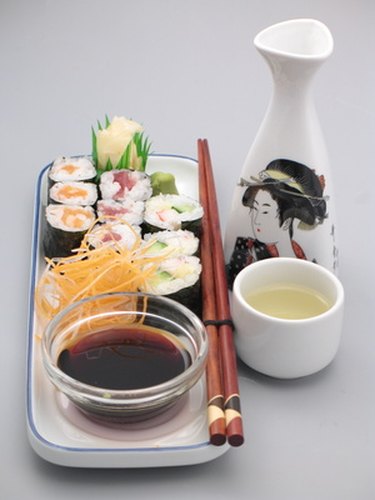
Kojic acid is a natural antibiotic product derived from koji malt (aspergillus oryzae). Japanese cuisine uses koji malt in the production of foods such as soy sauce, sake and miso. Kojic acid has also been widely used as a preservative for meat and fresh vegetables, as well as an antioxidant for oils and fats. According to the Optiderma website, koji acid possesses antifungal and antibacterial properties. Additionally, the word "koji" is a common name for bacteria and means "culture" in Japanese.
Miso
Video of the Day
According to the World's Healthiest Food website, miso is a salty fermented paste derived from soybeans that forms the basis for soy sauce. The origins of miso are traced back to ancient China. Miso was introduced to Japan around the 7th century Water was added to the miso paste to make the thick, dark product known as tamari or soy sauce. Although usually made from soybeans, miso is also made by adding koji, to rice, barley, wheat and other ingredients and then allowing them to ferment. The fermentation process can take weeks to years depending on the type of miso. When the fermentation process is complete, the ingredients are ground into a paste resembling the texture of nut butter. Miso provides the trace minerals copper, manganese and zinc.
Video of the Day
Soy Sauce
Soy sauce is another food with a high kojic acid content. Soy sauce is also known as soya sauce, tamari and shoyu. Soy sauce was created in China as a condiment almost 2,500 years ago. Soy sauce provides niacin (vitamin B3), protein and manganese. Soy sauce is also naturally high in sodium.
Sake
Sake is a Japanse alcoholic beverage dating back to the 3rd century. Sake is made from rice, water, yeast and koji mold, also known as kojikin. A dark, fine powder made from kojikin is sprinkled over steamed rice that has been allowed to cool. The developing koji is then constantly checked during the next 36 to 45 hours, according to the Sake World website.
- National Institute of Health Pub Med: Evaluation of Health Aspects of Kojic Acid in Food
- International Agency for Research on Cancer: Kojic Acid
- World's Healthiest Foods: Miso
- World's Healthiest Foods: Soy Sauce (Tamari)
- Sake World: The Sake Brewing Process
- OptiDerma: Mushrooms in Skincare: What is Kojic Acid